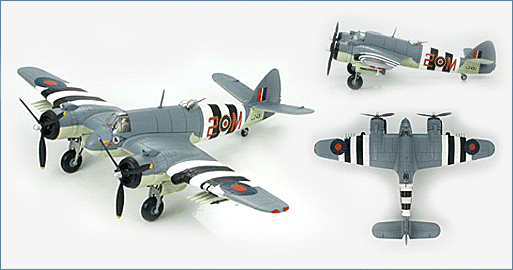Air Power Series>1:72 die-cast display model>Beaufighter>HA2309
Bristol Beaufighter TF.X LZ451, 404 Sqn. RCAF, RAF Coastal Command, Davidstow Moor, June 1944

General Background
The Bristol Beaufighter was developed in about 8 months by using sections from the earlier designed Bristol Beaufort. It was given more powerful engines and a variety of modifications making the aircraft capable of many tasks. It was a night fighter, fighter bomber and torpedo bomber performing anti-shipping duty as well as ground attack and long range interdiction. The different variants, 14 in all, were capable of carrying bombs, torpedoes, rockets, canons and machine guns. The Beaufighter was operated by 11 countries.
The Aircraft
The RCAF 404 Squadron was known as the “Buffalo Squadron”. In June 1944 the squadron
was part of RAF Coastal Command stationed at Davidstow Moor, in North Cornwall. On
June 4, 1944 the aircraft received their D-Day invasion stripes. On June 6, 1944 three
German Narvik Class destroyers were sighted proceeding up the English Channel towards
the D-Day landing. Fourteen Beaufighters from 404 were sent to intercept the ships. Armed
with 25-pound SAP (semi-armor piercing) RP (Rocket Projectiles) they found their targets
and attacked the lead ship and then the second. Both were left on fire while the third ship
used ship number 2 as cover. All aircraft returned to base to refuel and rearm for a second
strike. The ships were located again and with two of them smoking the third ship was the
main target. It too was set afire but as it turns out the three ships managed to limp back to
port and within two days they were back in the English Channel. It was later determined that
74 of the 96 RP’s found their targets. This time they encountered the 10th Destroyer Flotilla
that destroyed one ship, drove another onto the rocks and forced the third back to Brest.
RCAF 404 Squadron received their Beaufighters in September 1942 and never flew against
ground targets and never carried anything but RP’s. In April 1945 404 Squadron switched to
Mosquitos. LZ451 2-M (2 signifying Davidstow Moor) was crewed by F/L WR Christison
from Lennoxville, Quebec and F/L Toon.
Specifications :
| Dimensions | |
| Wing span: | 57 ft. 10 in. (17.64 m) |
| Length: | 41 ft. 4 in. (12.59 m) |
| Height | 15 ft. 10 in. (4.84 m) |
| Weight | |
| Empty: | 15,592 lb (7,072 kg) |
| Maximum: | 25,400 lb. (11,521 kg) |
| Disposable Load: | 9,808 lb. (4,448 kg) |
| Performance | |
| Powerplant: | 2 x Bristol Hercules XVII fourteen-cylinder two-row sleeve-valve radial engines |
| rated @ 1,725 hp (1,286 kw) @ 2,900 rpm for take-off | |
| rated @ 1,395 hp (1,040 kw) @ 2,400 rpm at 1,500 ft. (457 m) | |
| Maximum Speed: | @ sea-level - 320 mph (514 km/h) |
| Service Ceiling: | 19,000 ft. (5,791 m) (without torpedo) |
| Range | |
| with torpedo and normal fuel: | 1,400 miles (2,253 km) |
| with torpedo and long-range tanks: | 1,750 miles (2,816 km) |
| Armament: | 4 x 20-mm. Hispano cannon in the fuselage nose |
| 6 x 0.303-in. machine-guns in the wings | |
| 1 x 0.303-in Vickers "K" or 1 x Browning gun in the dorsal position | |
| 1 x 18-in. torpedo under fuselage | |
| 8 x rocket projectiles instead of wing guns |

